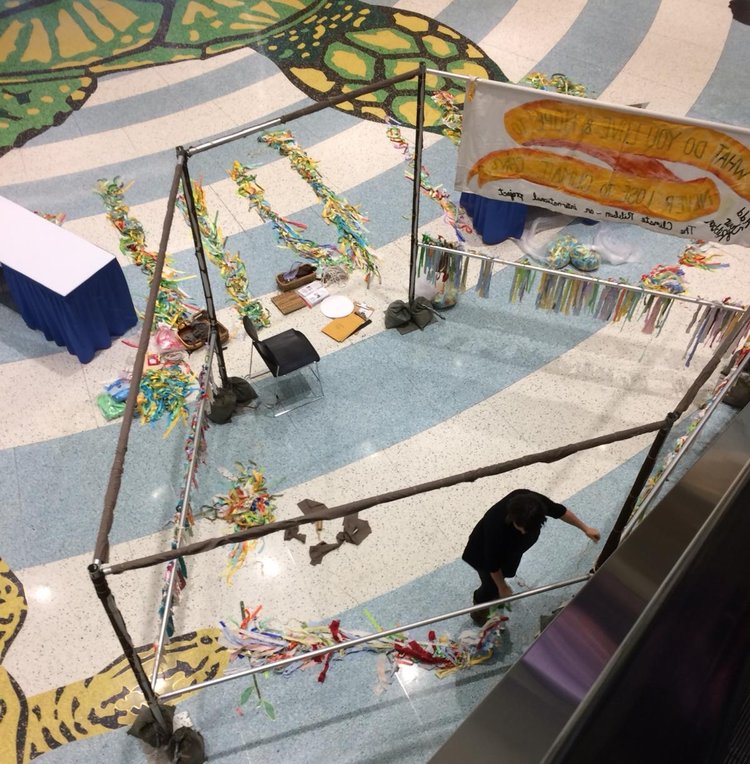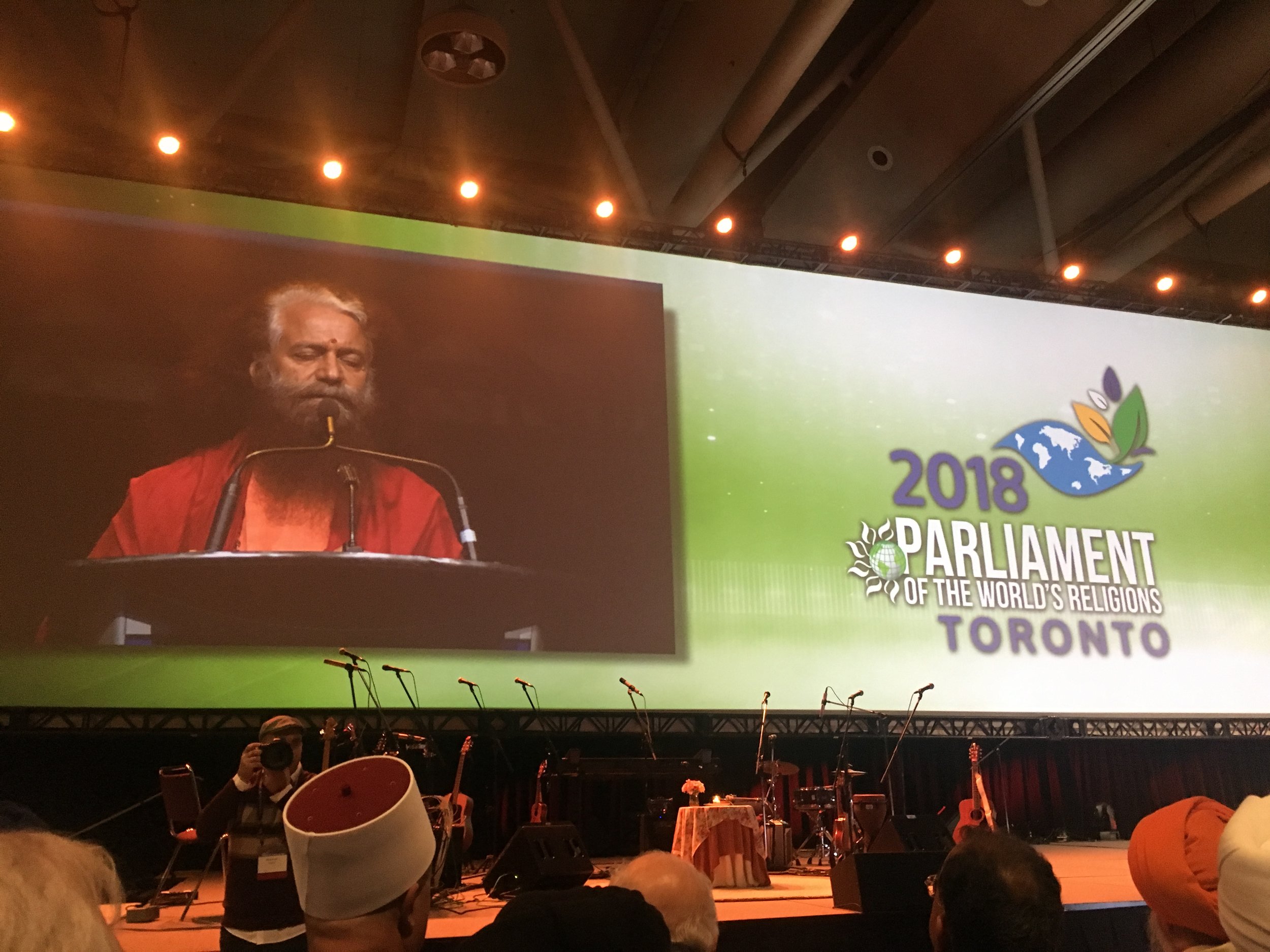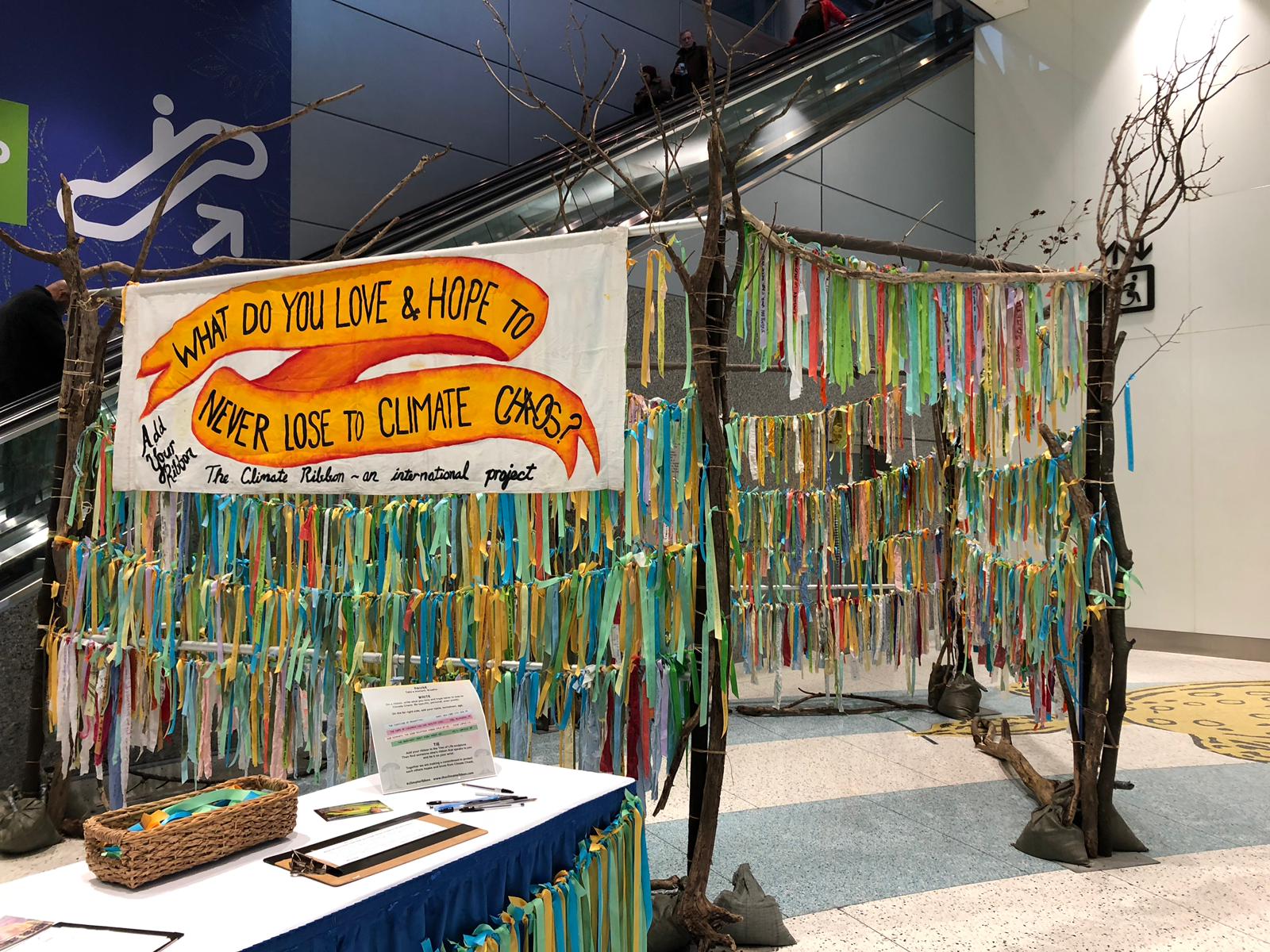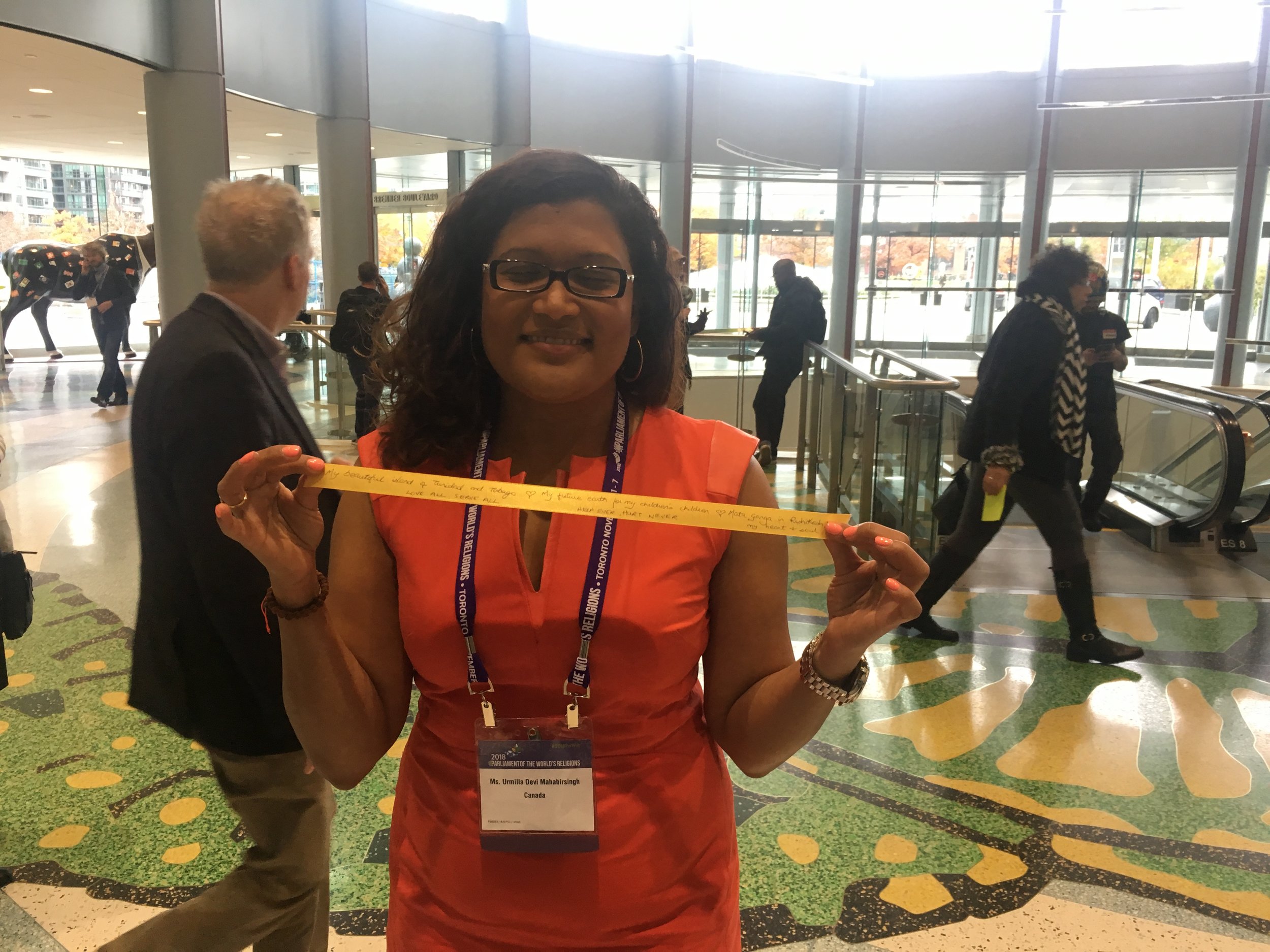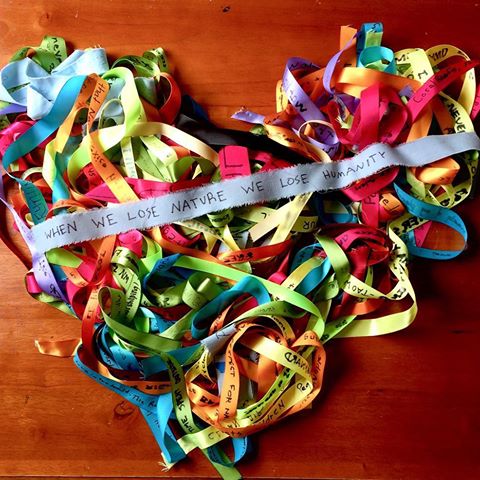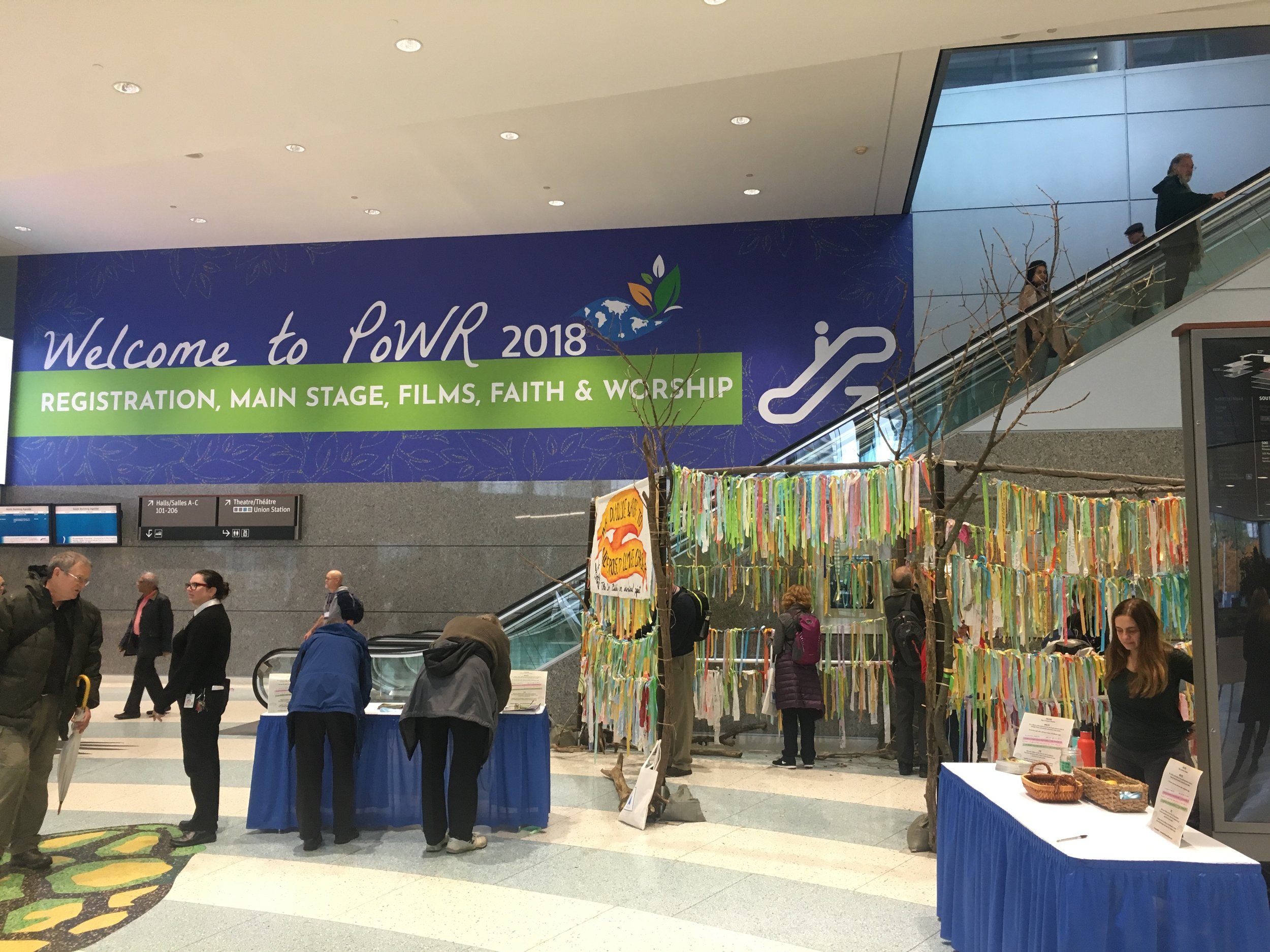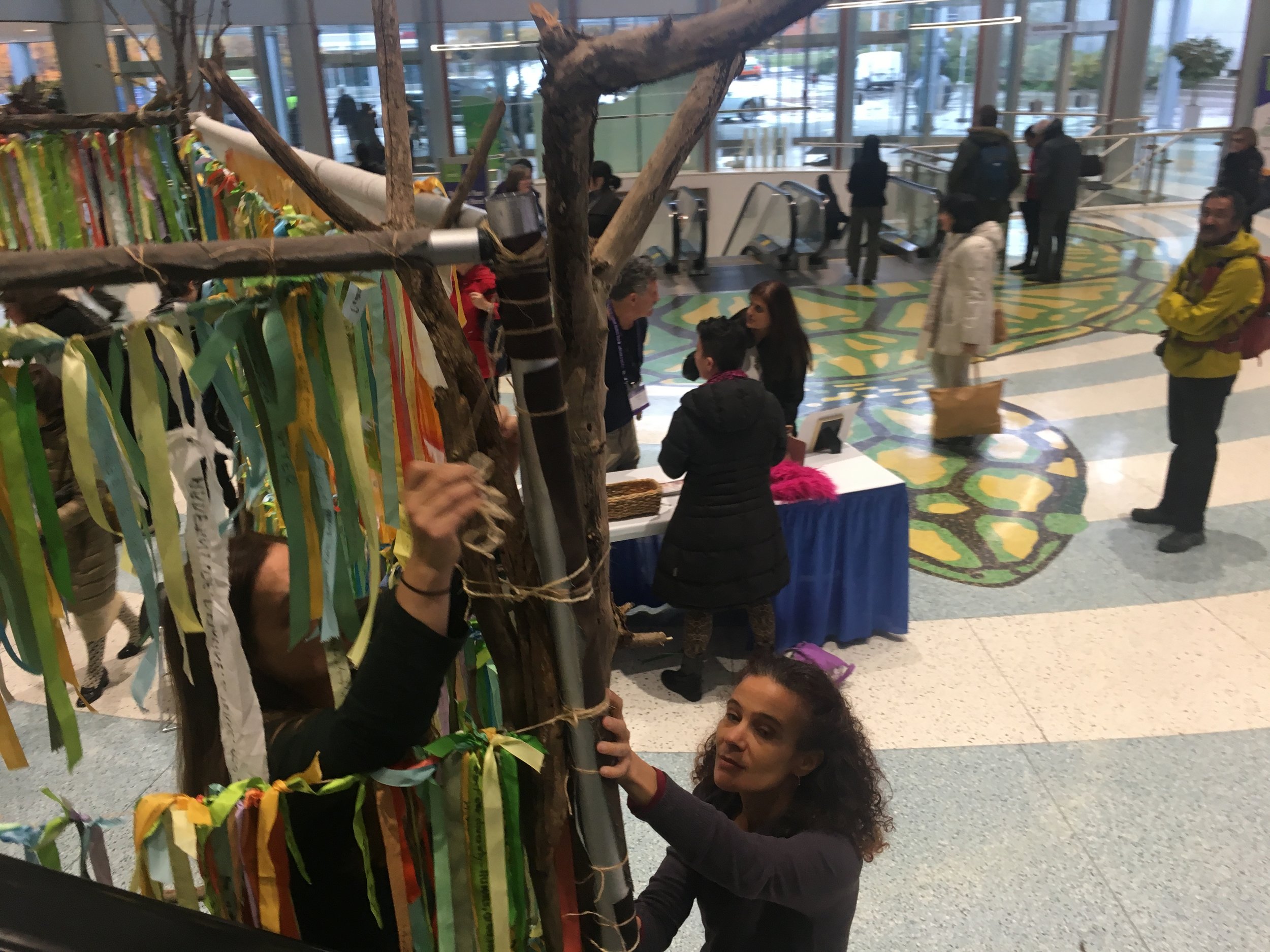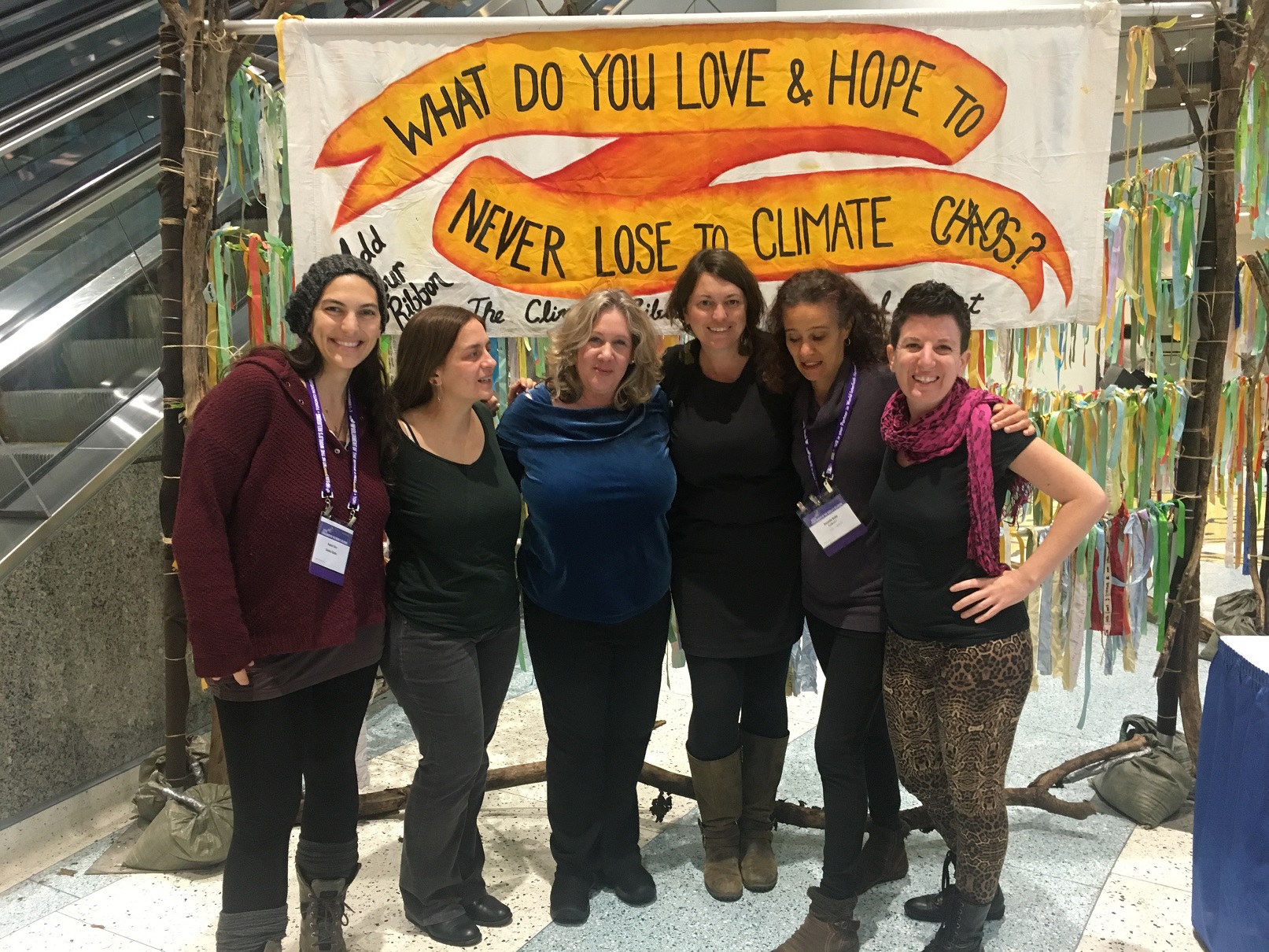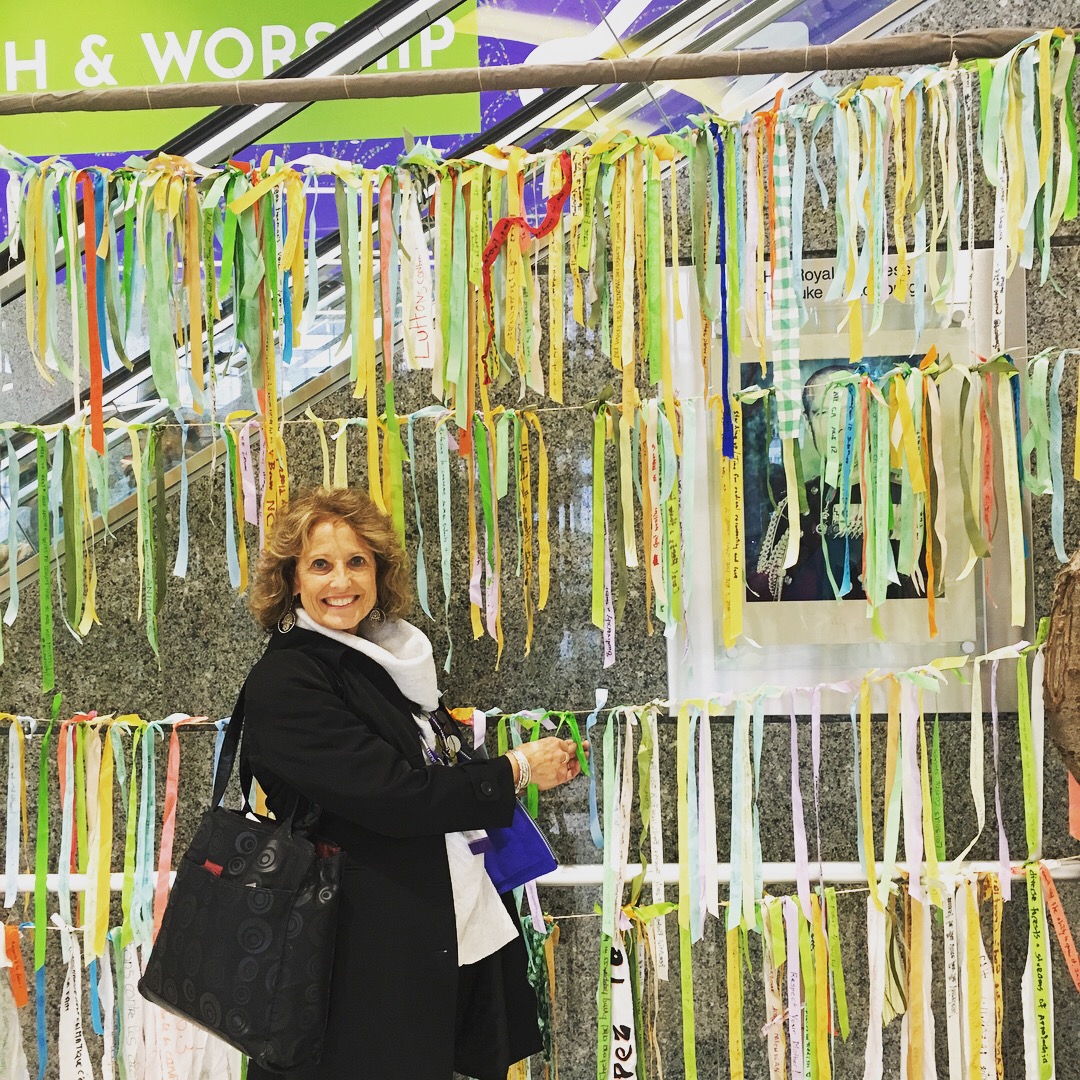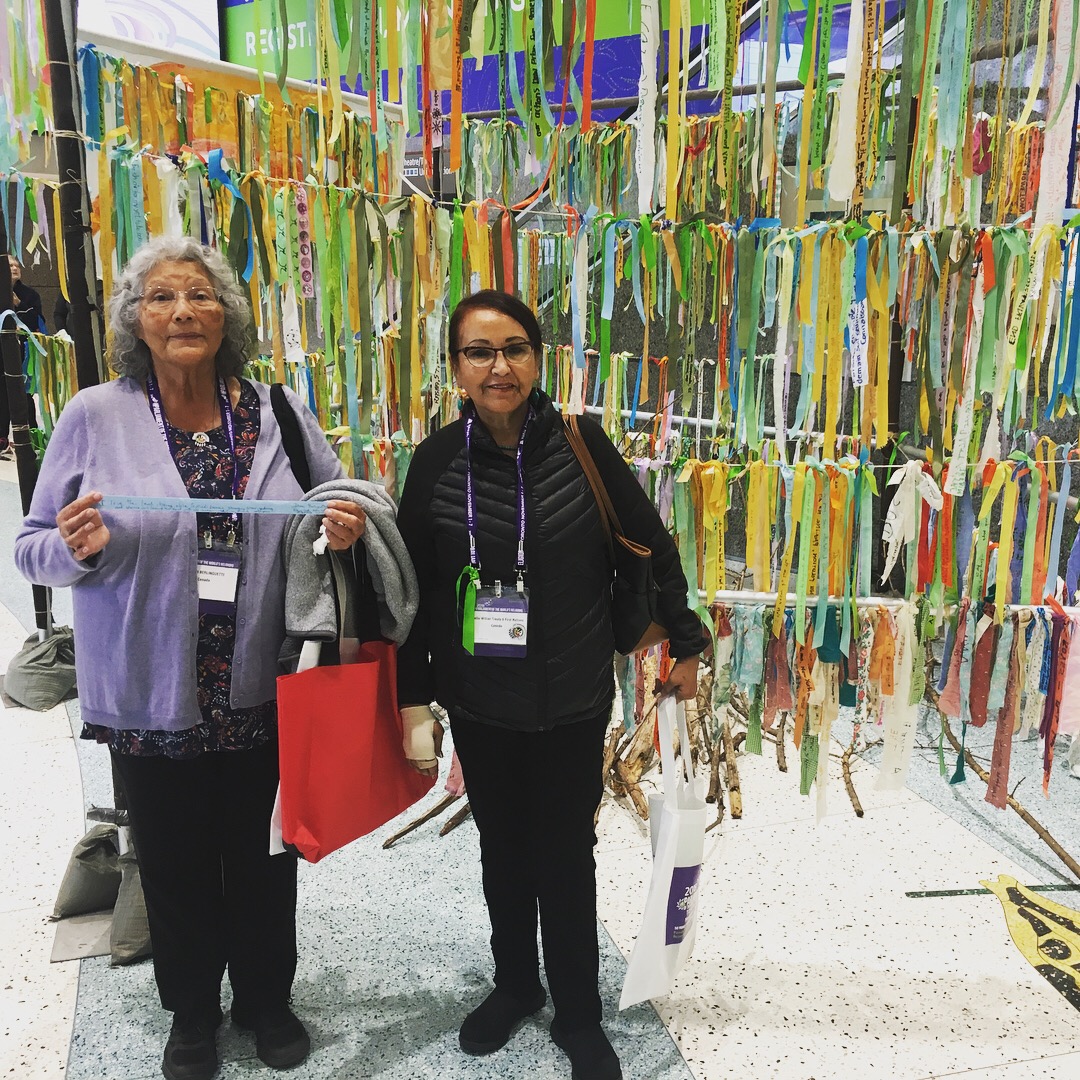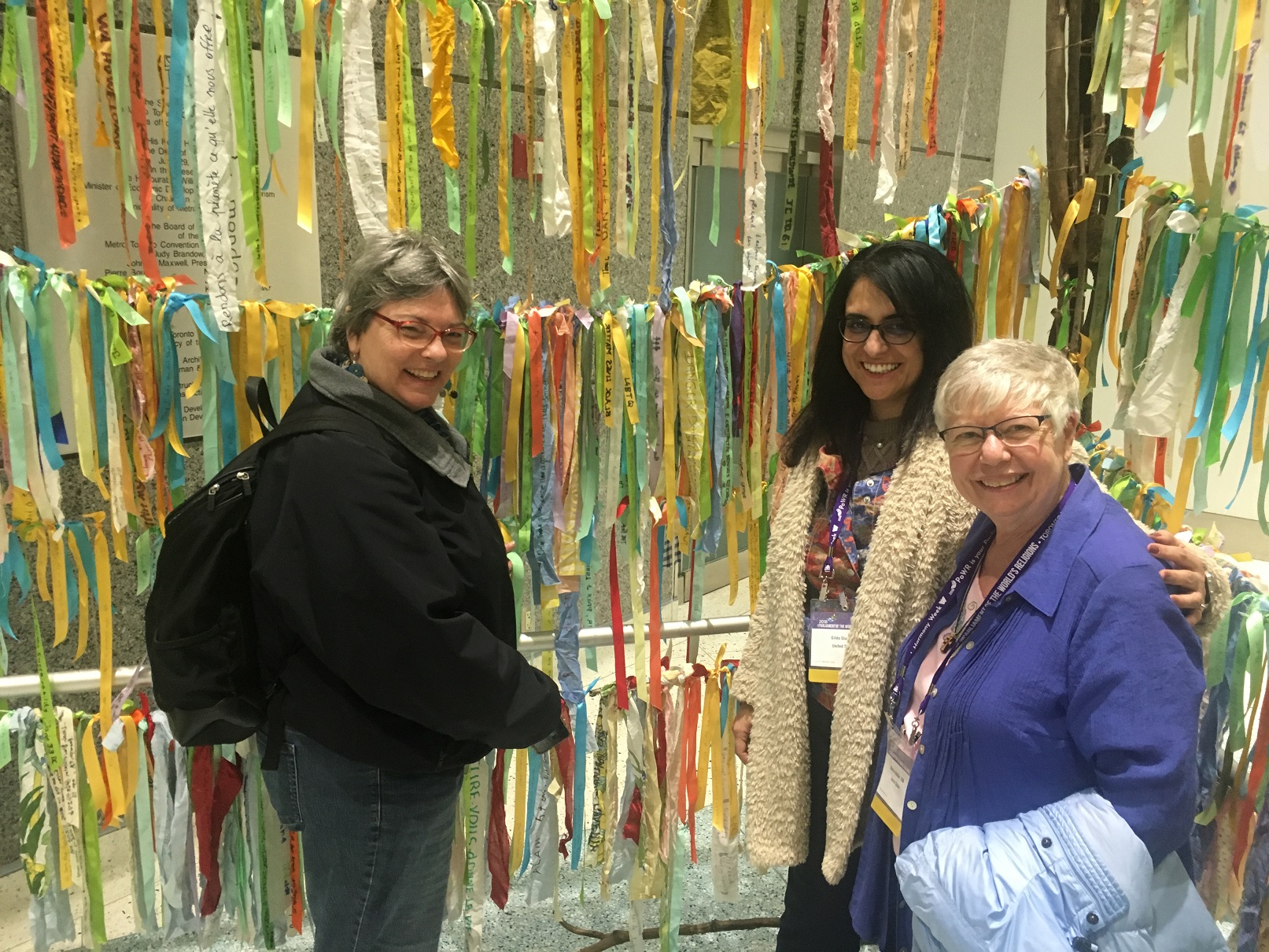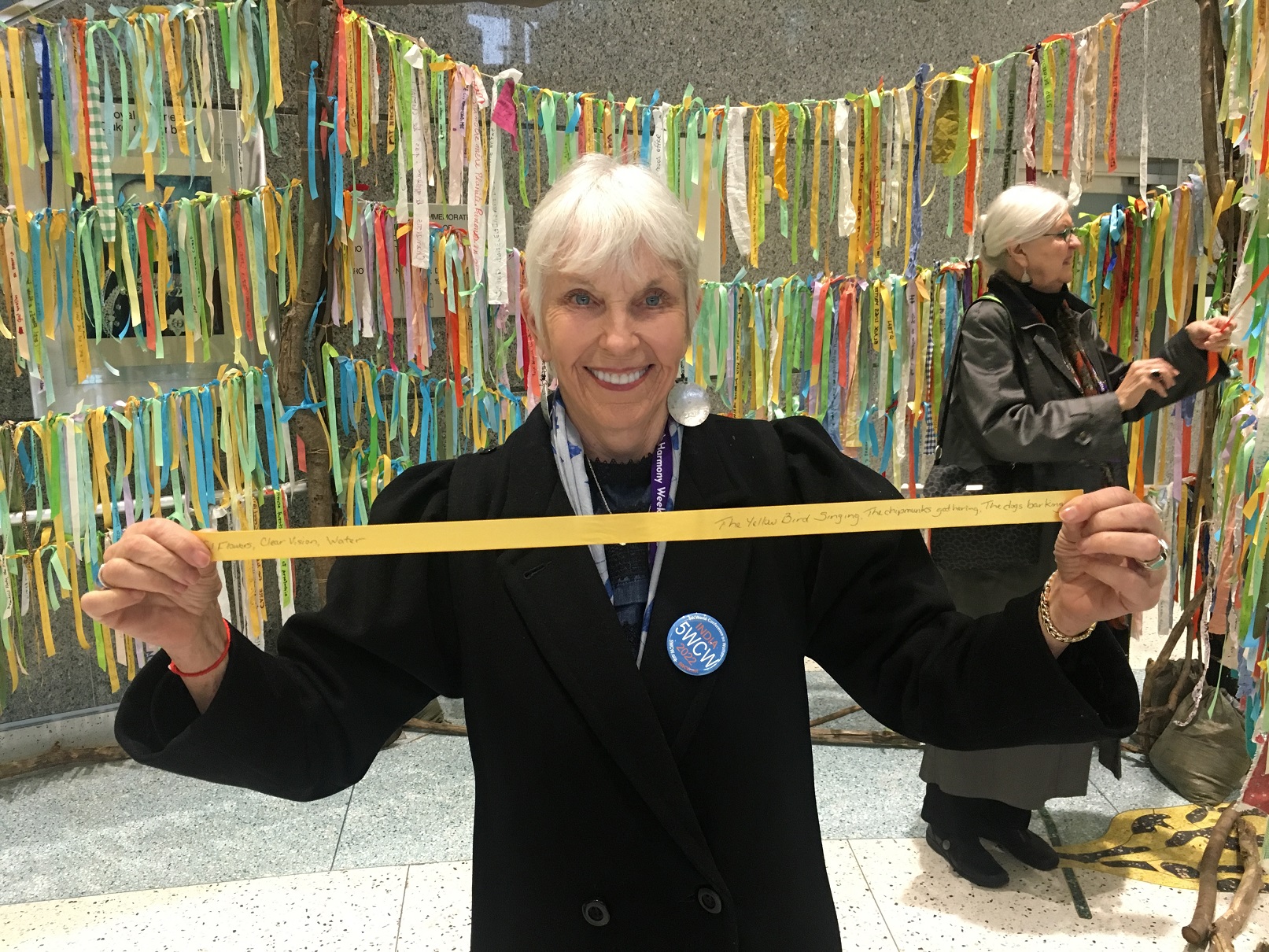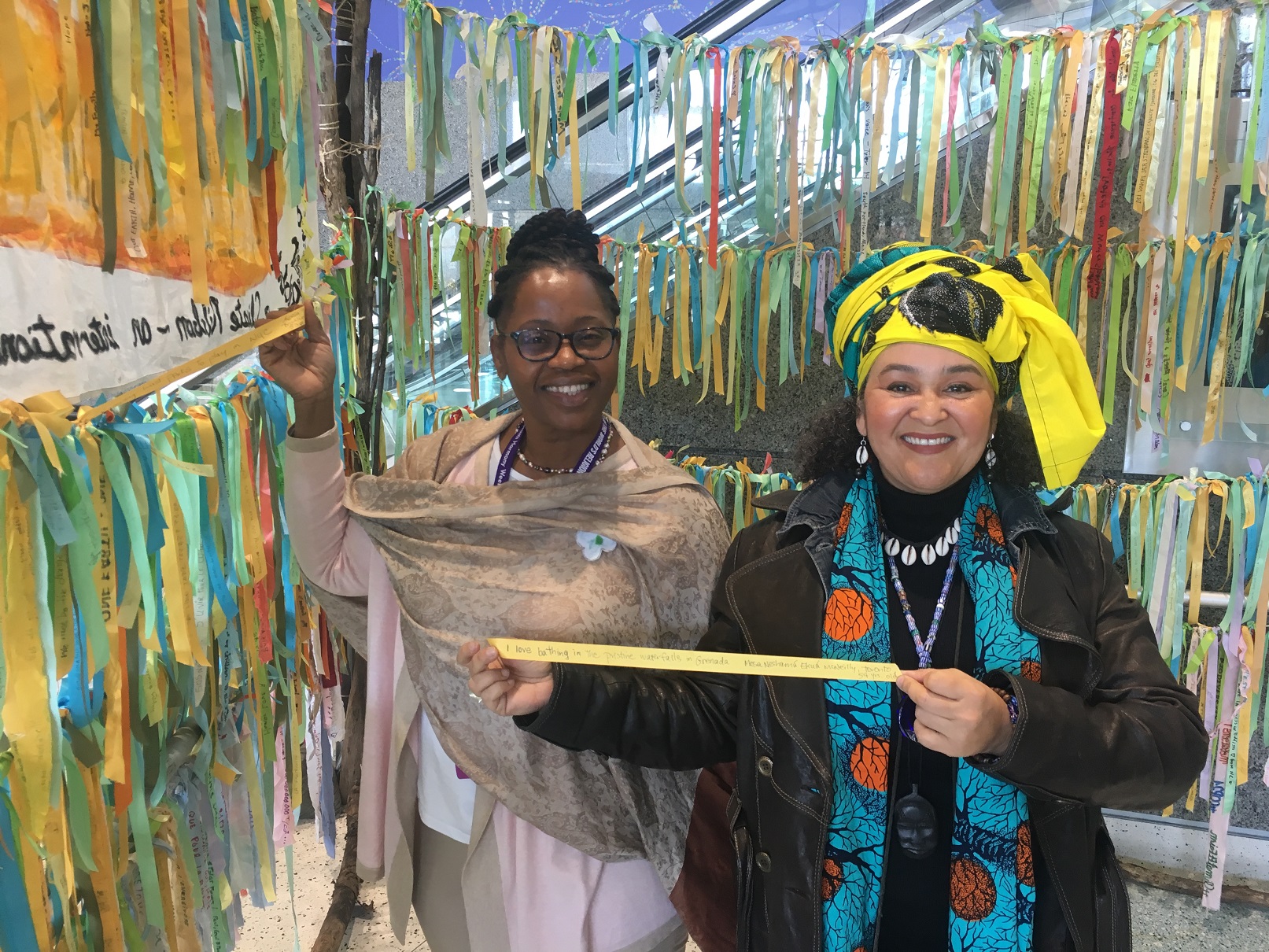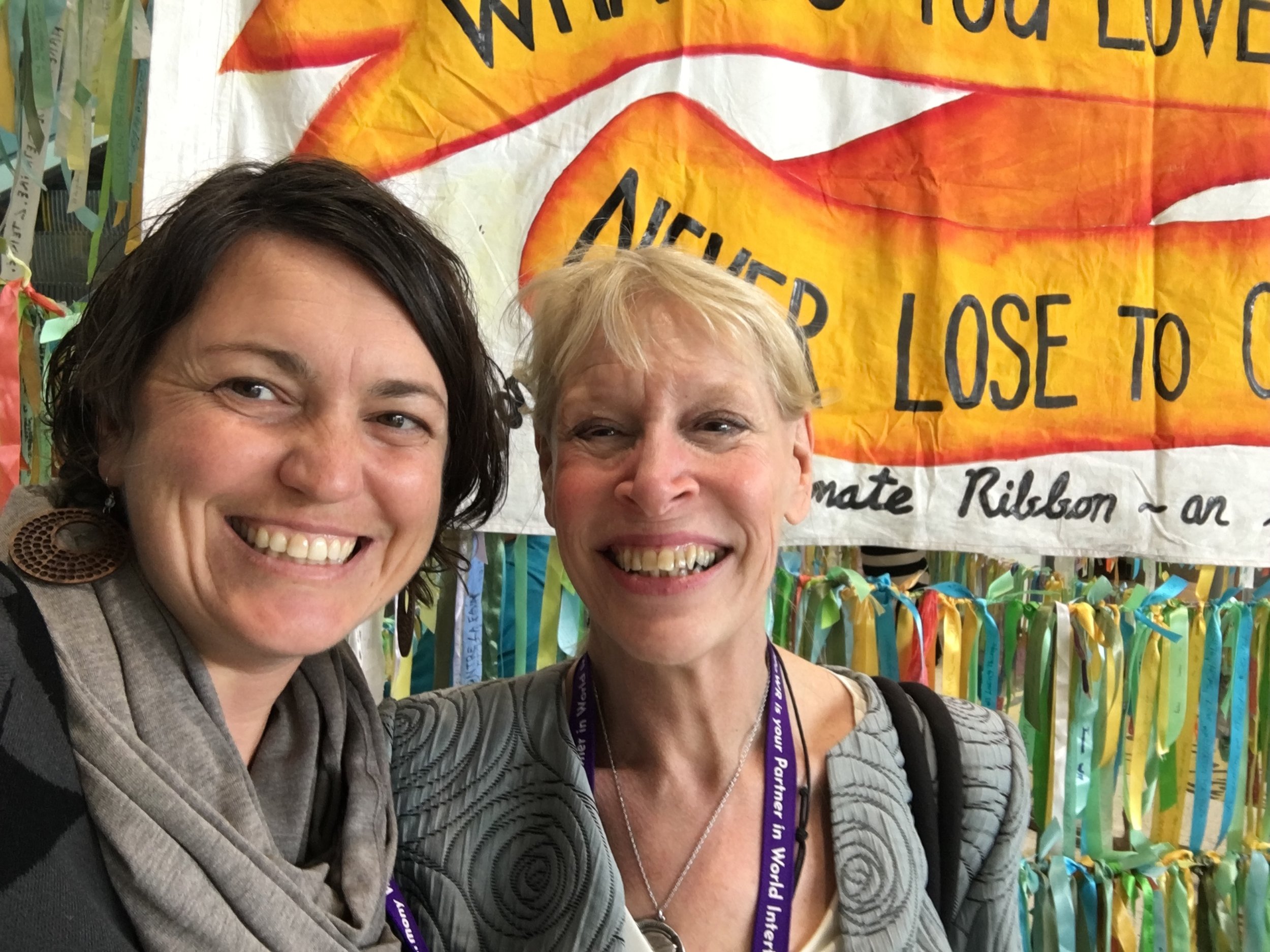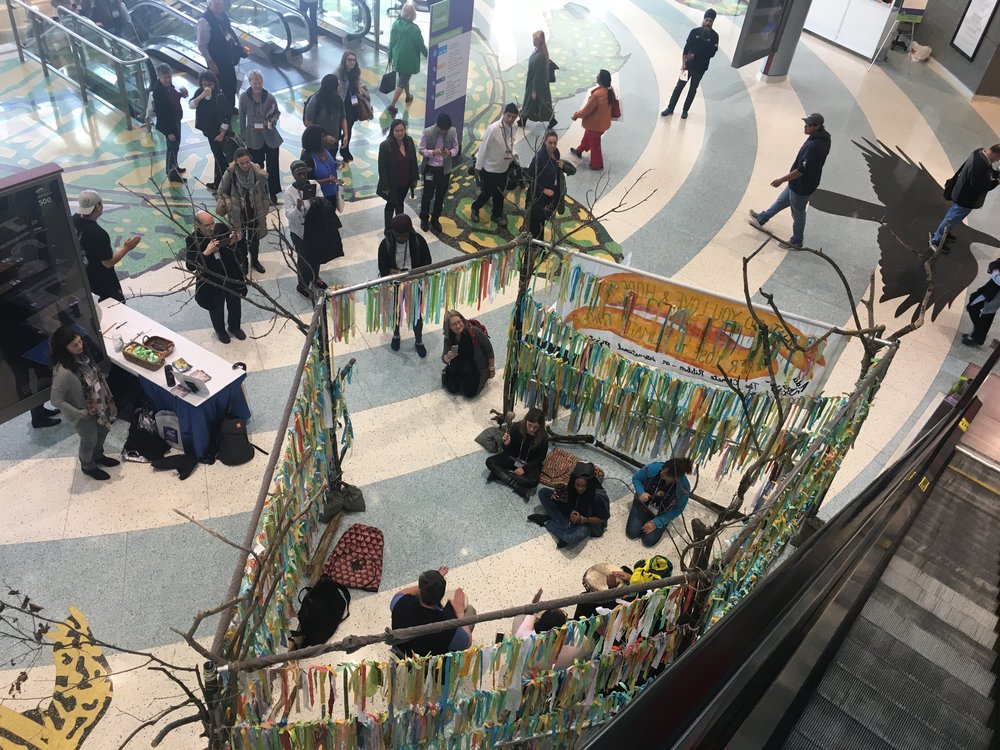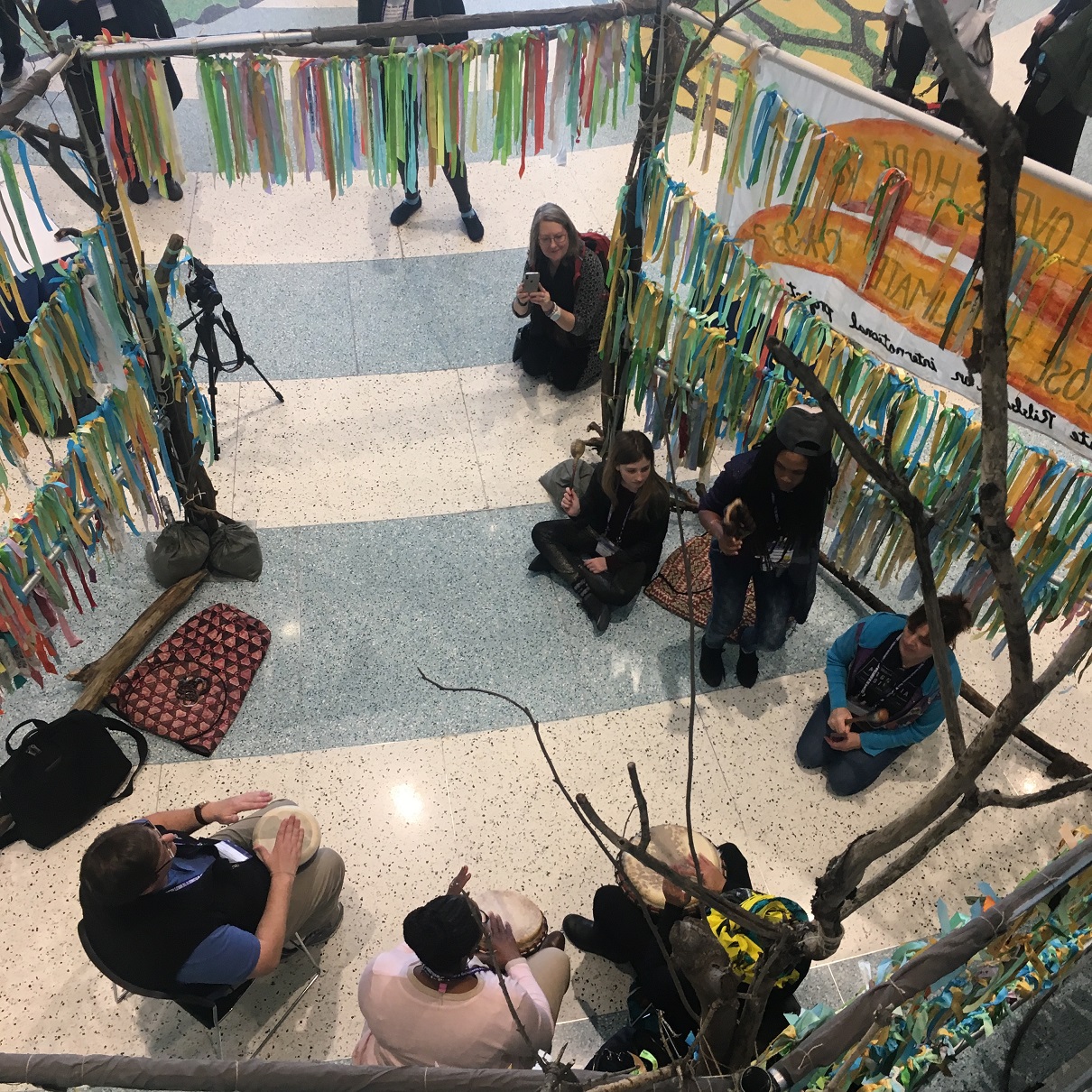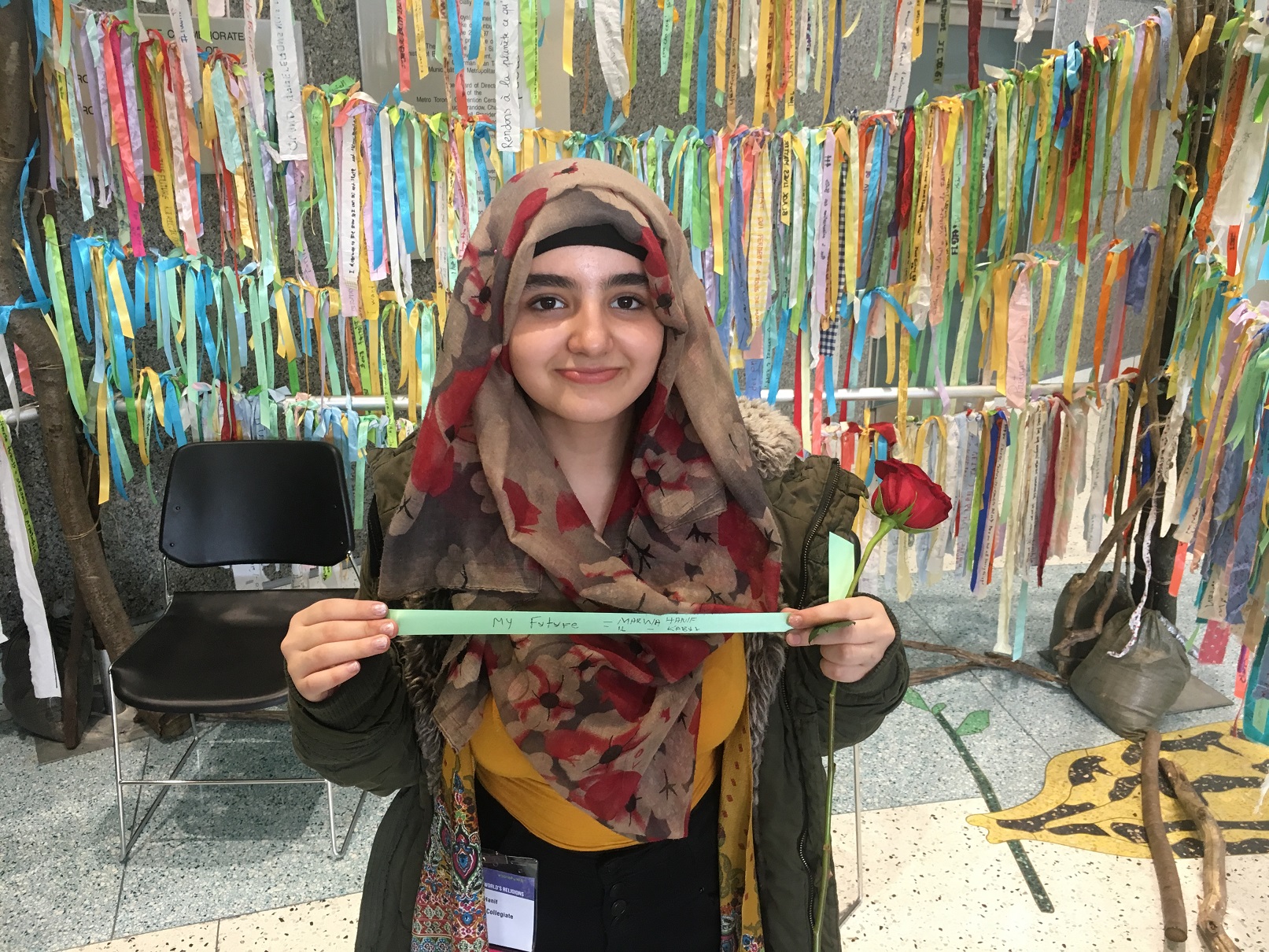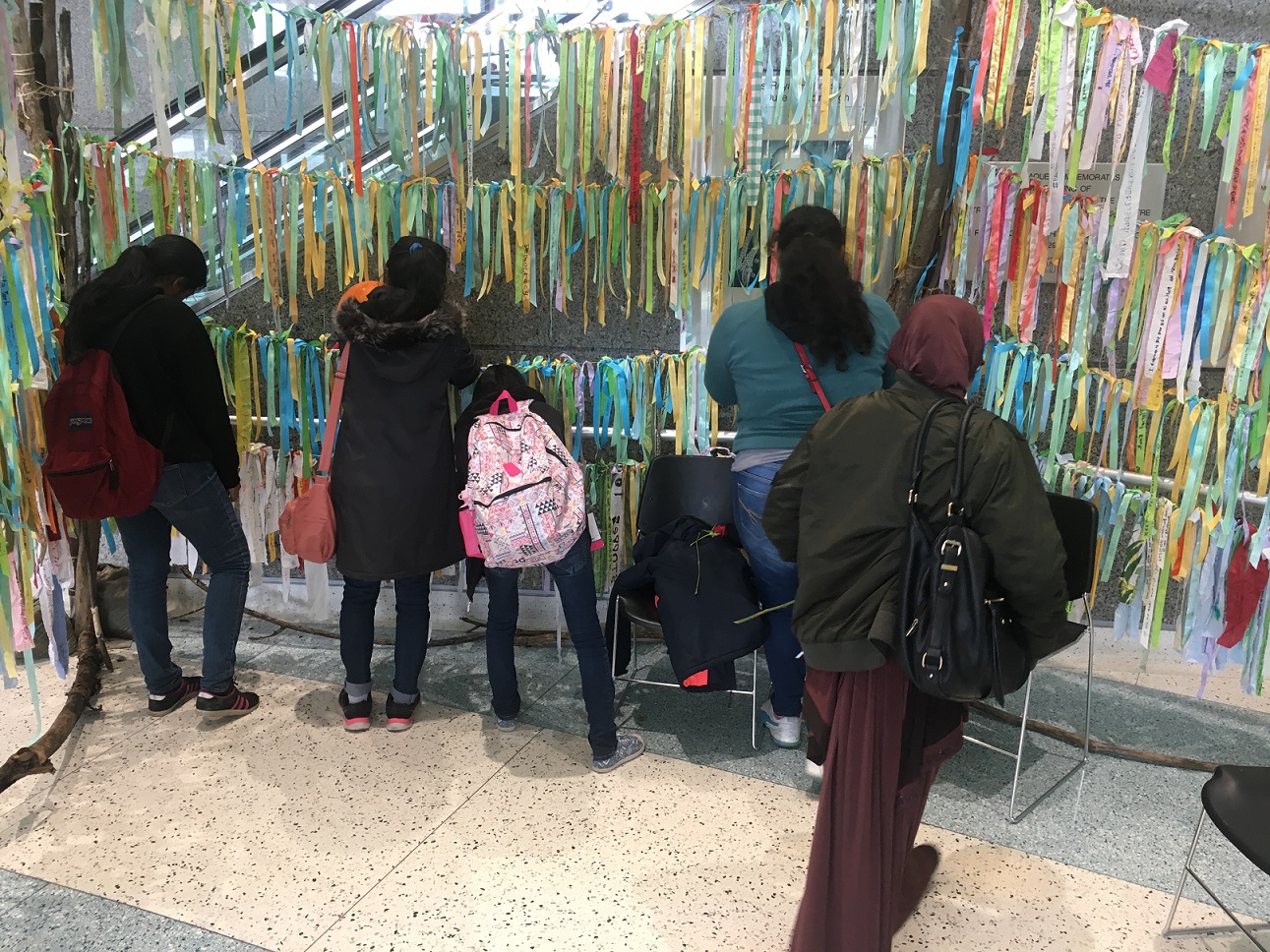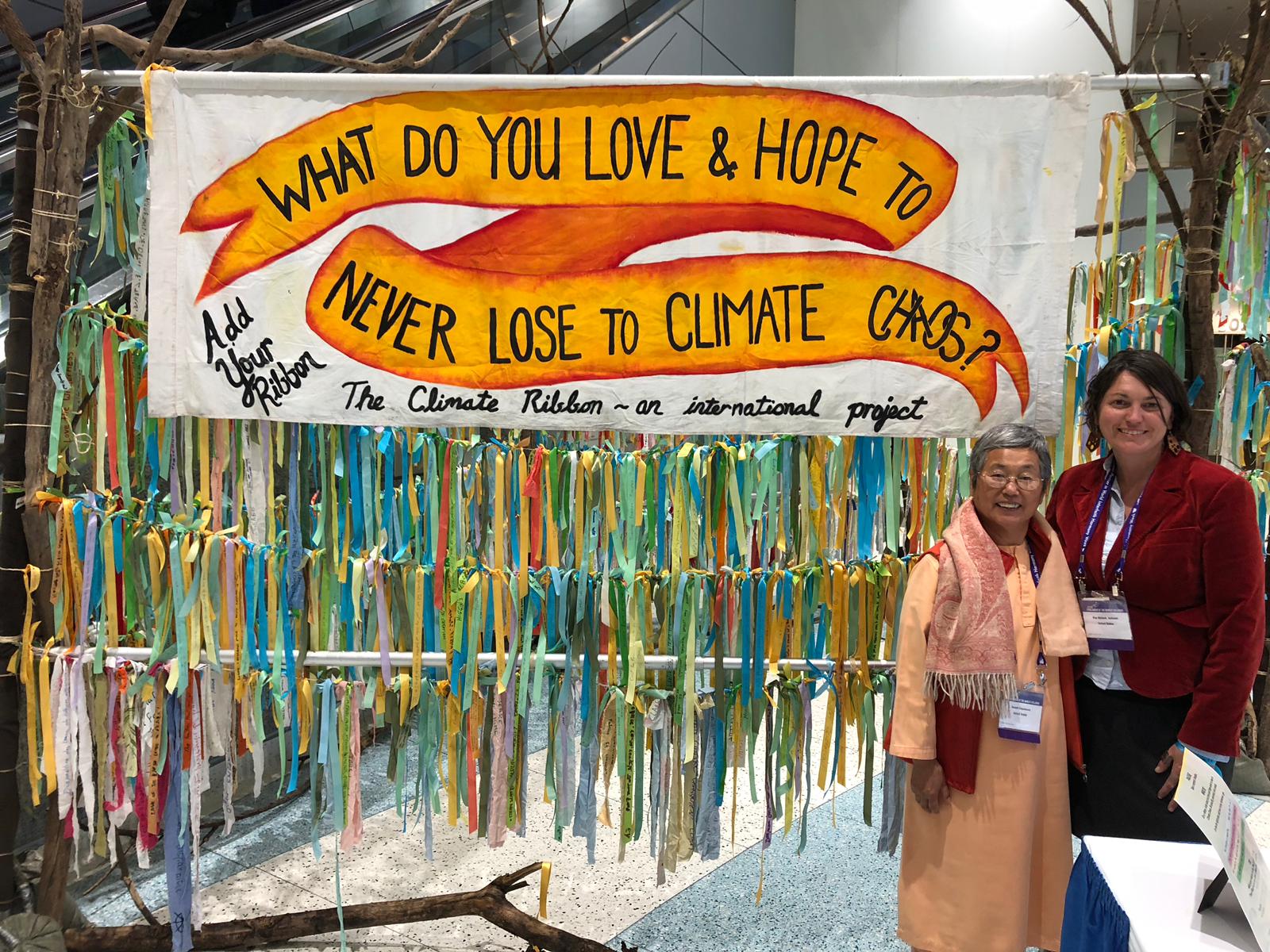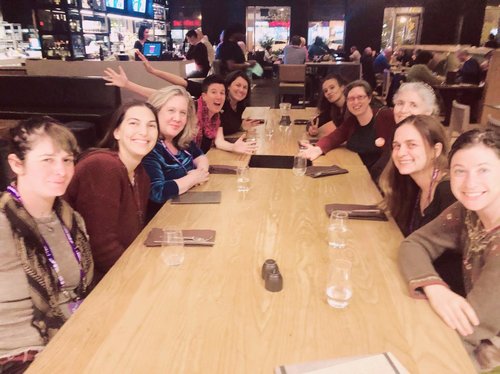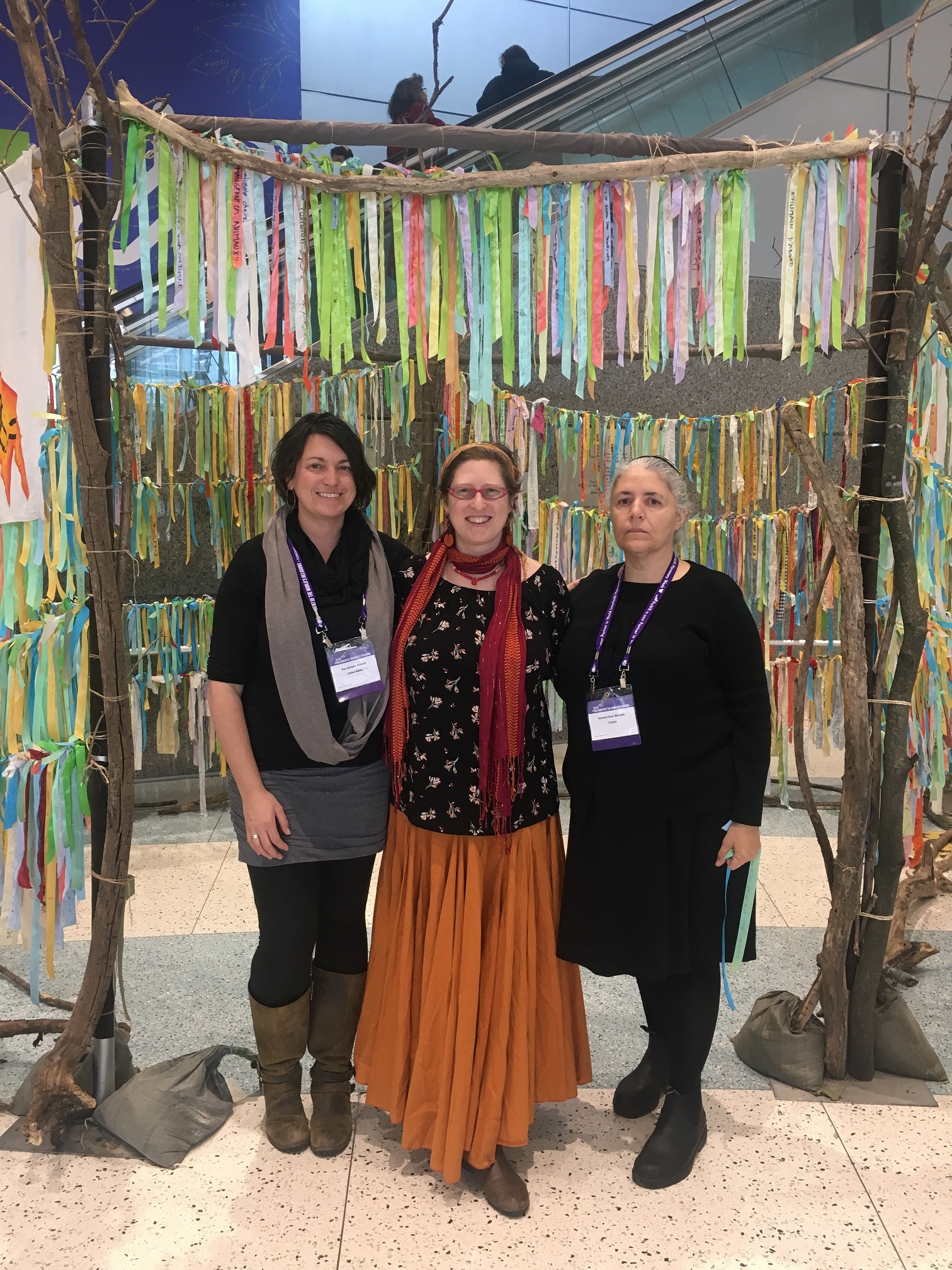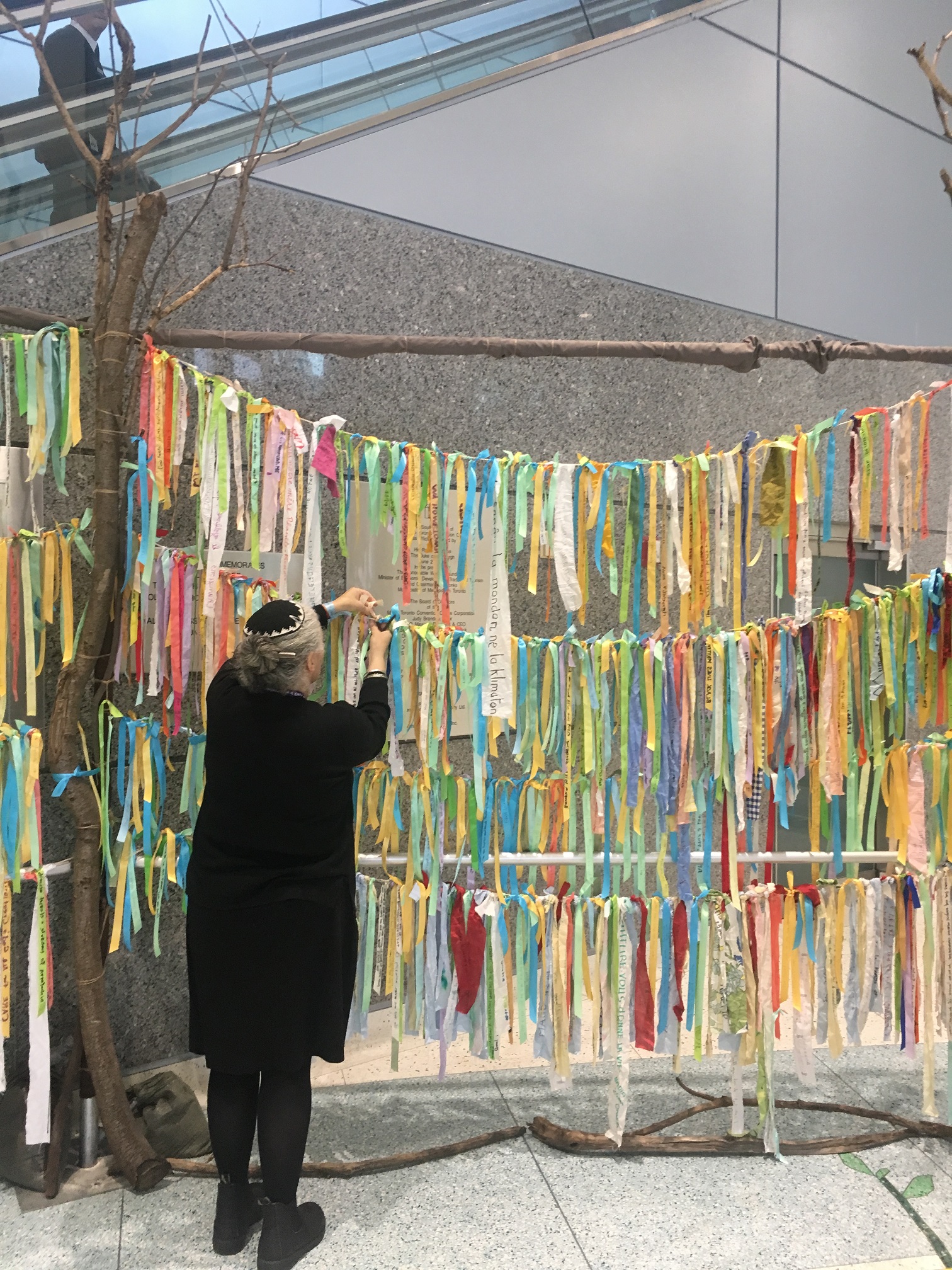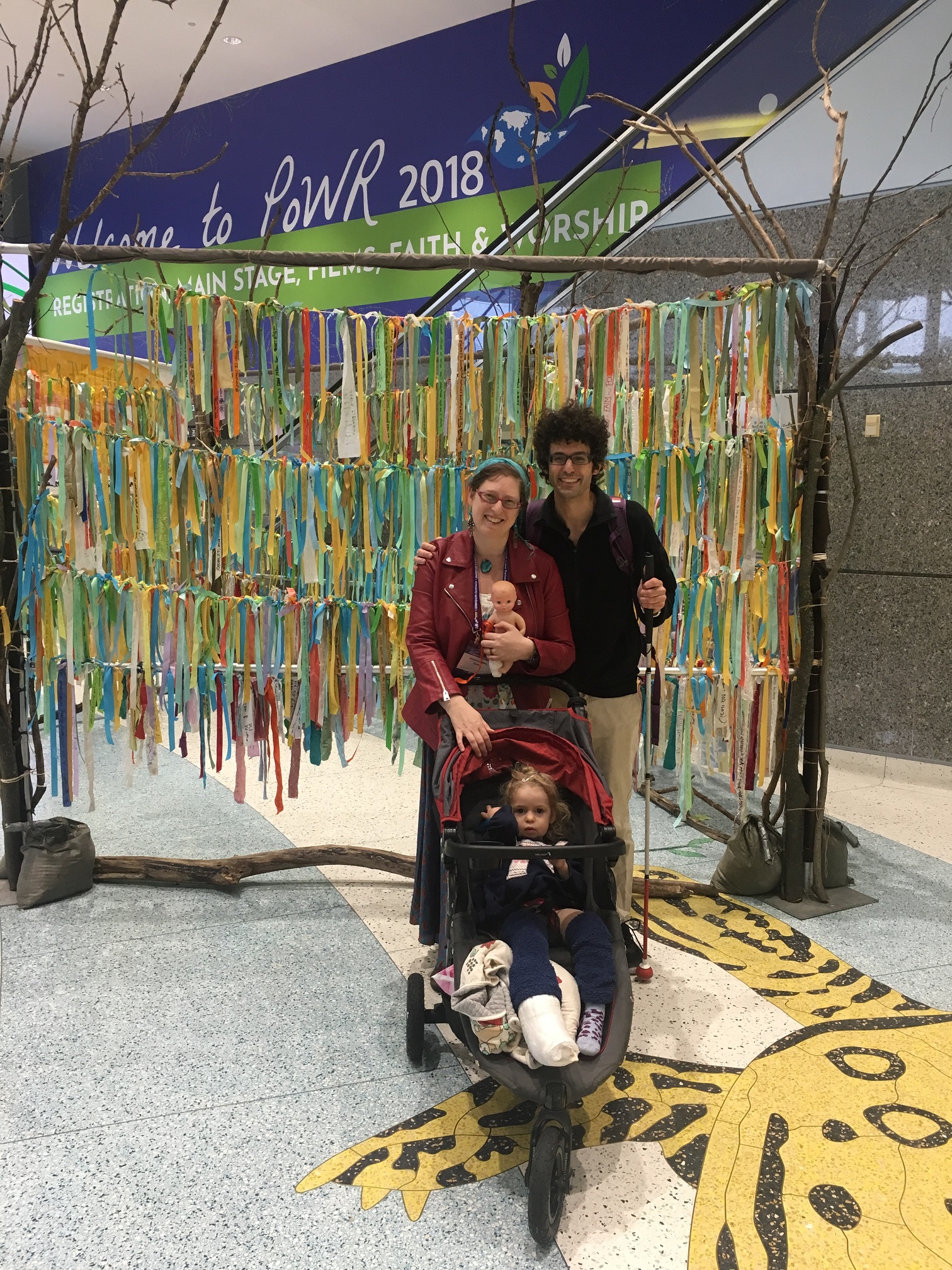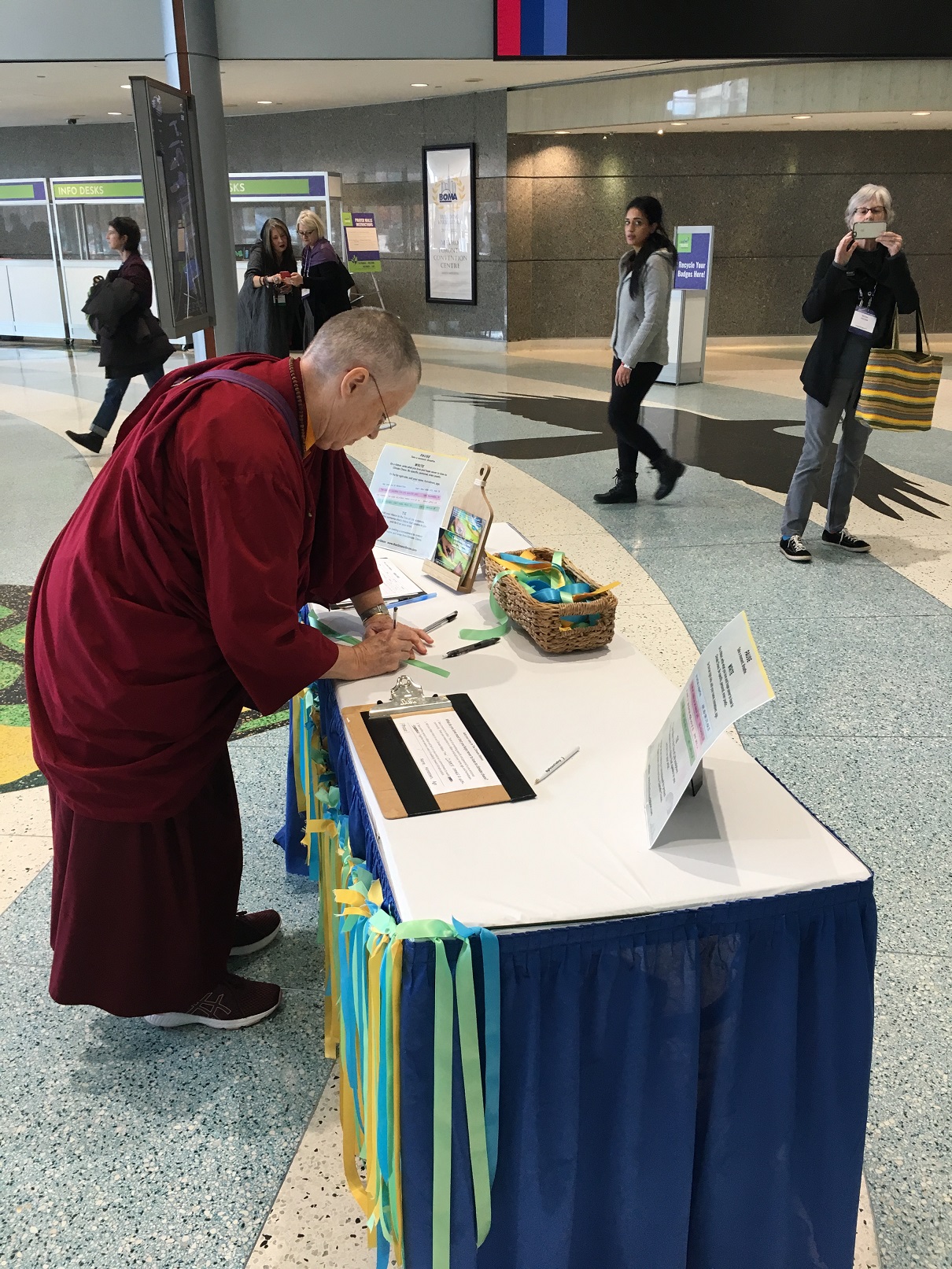The Ribbon returns to the Parliament with a new focus
In the first week of November 2018, over 7,000 people from all over the world converged in Toronto, Canada for the Parliament of the World’s Religions. The Climate Ribbon was there at the entryway to bring home the urgency of the climate crisis and to demonstrate a ritual pathway for faith leaders to engage congregants in making meaningful commitments to action.
This was not the first time the Climate Ribbon was woven into this conference.
We were at the previous Parliament (in Salt Lake City in 2015), where we set up a large Climate Ribbon installation at the entryway of the convention center. It was an instant hit, as participants were excited to make their ribbons immediately after registering. Led by clergy from many faiths, over a thousand people made ribbons and tied them onto a large story-sharing wall. We took these ribbons to Paris and gave them to UN negotiators at the historic COP21.
In 2018, our focus was different: to demonstrate the power of this simple ritual and encourage faith leaders to take it home to use in their congregations around the world.
A site-specific design
Every Climate Ribbon is customized for a location’s unique space and tone. So, our first challenge at the Metro Toronto Convention Center was how to transform this looming industrial entryway into a meaningful space for reflection and commitment. Using a combination of left-brain ritual technologies (floor plans, tape-measures, etc.) as well as right-brain skills (e.g. divination cards), our Climate Ribbon advance team, Rae Abileah, chose to build a womb-like grove of tree-sculptures with a ribboned doorway.
However, she was smack in the middle of Toronto’s concrete and steel downtown, so finding branches for the sculpture was no easy task. Luckily, a posse of Earth-centric Jewish priestesses, who just happened to have a giant orange cargo van, guided Rae to a nearby forest, along the way telling her the histories of all the green places in Toronto and their connections to indigenous peoples. This “great branch schlep” was completed in the dark of night of All Hallow’s Eve, and by the next morning the Climate Ribbon was ready to receive the faith-filled masses.
This sacred space drew in participants to not only make ribbons, but also to pray and make music together. Here’s a video of women drummers who uplifted the cavernous convention hall and brought people to make music and dance together!
The story-exchange
The Climate Ribbon greeted Parliament-goers with a grove of trees strung with brightly-colored ribbons, and a table on which a simple question appeared: What do you love and hope never to lose to Climate Chaos? Participants wrote down their personal answers to this question (alongside their name, age, and hometown), and tied their ribbon to the grove of trees. Then, looking through all the ribbons tied there, they found a stranger’s story that moved them, untied it from the Tree, and carried it with them throughout the Parliament. In the process of this sacred story-exchange, they became the guardian of what someone else most loves that’s under threat from Climate Chaos — and in order to protect it, they made a vow to take action for climate justice and a renewable energy future.
Typically, when we explain the last step of the ritual, people respond with a shocked, “You mean I can actually take one?! Oh, no, I couldn't possibly do that!” But at the Parliament, we found two differences in the way people responded. First, the written instructions were enough to communicate all the steps of the ritual, (including the last step in which people are asked to take a ribbon home with them). As faith healers, they understood immediately. After all, ritual is the water they swim in. For us, this was yet another proof-of-concept that the Climate Ribbon works really well within faith communities.
Second, attendees took the exchange very, very seriously. In many instances, people were physically struck, sometimes moved to tears, by the invitation to take home each others’ ribbons. They made heartfelt, emotional commitments to each other.
One woman about the waters on the land she grew up on in northern Canada, and shared her story of struggle for her people’s indigenous sovereignty in Canada… After she tied her ribbon up, she palmed through the hanging ribbons and selected a blue one. “What does it say?” Rae asked her. “Oh! It’s about the waters in Canada! How amazing to find a ribbon like mine!” she exclaimed. As it turned out, the ribbon was written by Salim, one of the employees at the convention center. Rae was later able to tell each about the other, and they were both moved. This is why the Climate Ribbon describes the experience as an “intimate solidarity”; people discover their common ground and sacralize their shared commitments in a very specific and personal way.
Abby Mohaupt, Co-Director of the Green Seminary Initiative, shared how crucial a moment the ribbon-exchange was for her. She wore her ribbon on her wrist for the rest of the Parliament, and when she returned to her home on the California coast she was confronted with a question: what to do now with the ribbon? She decided to tie the ribbon around her grandmother’s lamp, a family heirloom symbolic of the light through the generations, as a daily reminder of her commitment to take prayerful and practical action for climate justice.
A new commitment, a new ritual technology
On the fifth day of the Parliament, after thousands of people had already interacted with the Climate Ribbon, Rae and Greenfaith communications coordinator Brett Fleishman, co-facilitated our workshop. Our general question was, “How do we make climate change meaningful for our congregants?” And our specific question was, “How can we use the Ribbon to sacralize our commitments to action and integrate that ritual into our congregation back home?” After guiding participants through the basic ritual, they asked them to turn their ribbons over and write one concrete, tangible action-step they were committing to take towards a renewable energy future. After exchanging ribbons, everyone took turns reading aloud what the author loved too much to lose, after which everyone declared, “We are with you.” Then, after each individual shared the commitment they had made, the group responded, “Your commitment strengthens mine.”
After the ritual, Swami Dayananda, who is opposing a new pipeline in her Virginia backyard, relayed her thoughts: “I didn’t realize how meaningful it would be to hear people say that to me. I didn’t know how much I needed that kind of support.”
Greenfaith created a facebook live interview with the Climate Ribbon onsite which built the conversation beyond the conference.
Furthermore, the Climate Ribbon was the lead-off topic in the article “Catholics Play a Key Role in Parliament of the World’s Religions in Toronto.”
What do you love?
At another session, Margaret Atwood, renowned Canadian author, poet, and environmental activist, responded provocatively to the Ribbon’s central question: “It doesn’t matter what I love,” said Atwood. “It matters whether there will be a world for younger generations.”
We now have ribbons from Margaret Atwood, Vandana Shiva, and Al Gore to name just a few celebrities who’ve participated in the project. But the most poignant comments come from everyday climate heroes:
La belleza de la vida — Adriana, 40, Puerto Rico
The Gaspe (accent) Peninsula of Canada, home of my ancestors — Michelle Landry, 67, Thunder Bay, ON, Canada
The livelihood of the crabbing community that has lived for generations on the eastern seashore of Maryland — Chloe Lansdale, 26, Bethesda, MD
The swaying, the crashing, the humming, the cries of my Mother who delivered my ancestors here safely. May we never lose the embrace of her waves or miss the song she sings to us. — Des, 29, Toronto, ON, Canada
On the closing day of the Parliament, as the sacred fire was closed by indigenous elders outside, we untied the ropes of ribbons, and one more woman approached to make a ribbon. She wrote:
My beautiful island of Trinidad and Tobago ~ Future earth for my children’s children ~ Mata ganga in Rishikesh, India — Urmilla Devi Mahabirsingh, Toronto, ON, Canada, 45, and forever young in spirit
The Climate Ribbon @ the 2018 Parliament was created by Rae Abileah with help from many volunteers. The project would like to thank the Bronner family for their generous support, and Rae would especially like to thank the Kohanot, ordained Hebrew Priestesses. The Climate Ribbon could not have happened at the scale it did without their generosity of spirit, hard work, and ritual facilitation. The project is deeply grateful for the way that this group of earth-centered, feminist clergy came together to help create, facilitate, and then take down this offering!
